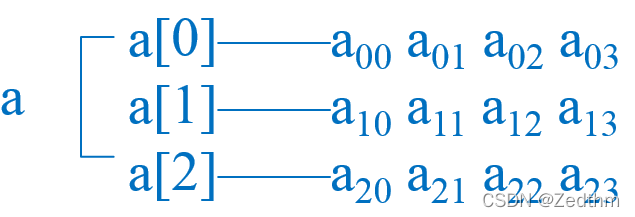目录
数组的定义与使用
-
数组是具有一定顺序关系的若干相同类型变量的集合体,组成数组的变量称为该数组的元素。
数组的定义

-
例如:
int a[10];
表示a为整型数组,有10个元素:a[0]...a[9] -
例如:
int a[5][3];
表示a为整型二维数组,其中第一维有5个下标(0~4),第二维有3个下标(0~2),数组的元素个数为15,可以用于存放5行3列的整型数据表格。
数组的使用
-
使用数组元素
必须先声明,后使用。
只能逐个引用数组元素,而不能一次引用整个数组
例如:
a[0]=a[5]+a[7]-a[2*3]例如:
b[1][2]=a[2][3]/2例6-1
#include <iostream>
using namespace std;
int main() {
int a[10], b[10];
for(int i = 0; i < 10; i++) {
a[i] = i * 2 - 1;
b[10 - i - 1] = a[i];
}
for(int i = 0; i < 10; i++) {
cout << "a[" << i << "] = " << a[i] << " ";
cout << "b[" << I << "] = " << b[i] << endl;
}
return 0;数组的存储与初始化
一维数组的存储
数组元素在内存中顺次存放,它们的地址是连续的。元素间物理地址上的相邻,对应着逻辑次序上的相邻。
例如:

一维数组的初始化
在定义数组时给出数组元素的初始值。
-
列出全部元素的初始值
例如:
static int a[10]={0,1,2,3,4,5,6,7,8,9};-
可以只给一部分元素赋初值
例如:
static int a[10]={0,1,2,3,4};-
在对全部数组元素赋初值时,可以不指定数组长度
例如:
static int a[]={0,1,2,3,4,5,6,7,8,9}二维数组的存储
-
按行存放
例如:
float a[3][4];可以理解为:

其中数组a的存储顺序为:
a00 a01 a02 a03 a10 a11 a12 a13 a20 a21 a22 a23二维数组的初始化
-
将所有初值写在一个{}内,按顺序初始化
-
例如:
static int a[3][4]={1,2,3,4,5,6,7,8,9,10,11,12}
-
-
分行列出二维数组元素的初值
-
例如:
static int a[3][4]={{1,2,3,4},{5,6,7,8},{9,10,11,12}};
-
-
可以只对部分元素初始化
-
例如:
static int a[3][4]={{1},{0,6},{0,0,11}};
-
-
列出全部初始值时,第1维下标个数可以省略
-
例如:
static int a[][4]={1,2,3,4,5,6,7,8,9,10,11,12}; -
或:
static int a[][4]={{1,2,3,4},{5,6,7,8},{9,10,11,12}};
-
注意:
-
如果不作任何初始化,内部auto型数组中会存在垃圾数据,static数组中的数据默认初始化为0;
-
如果只对部分元素初始化,剩下的未显式初始化的元素,将自动被初始化为零;
-
现在我们来看一个用数组存放Fibonacci数列的例子。
例: 求Fibonacci数列的前20项
#include <iostream>
using namespace std;
int main() {
int f[20] = { 1,1 }; //初始化第0、1个数
int i = 0;
for (i = 2; i < 20; i++) //求第2~19个数
f[i] = f[i - 2] + f[i - 1];
for (i = 0; i < 20; i++) { //输出,每行5个数
if (i % 5 == 0) cout << endl;
cout.width(12); //设置输出宽度为12
cout << f[i];
}
return 0;
}运行结果:

一维数组应用举例
循环从键盘读入若干组选择题答案,计算并输出每组答案的正确率,直到输入ctrl+z为止。
每组连续输入5个答案,每个答案可以是'a'..'d'。
例: 一维数组应用举例
#include <iostream>
using namespace std;
int main() {
const char key[ ] = {'a','c','b','a','d'};
const int NUM_QUES = 5;
char c;
int ques = 0, numCorrect = 0;
cout << "Enter the " << NUM_QUES << " question tests:" << endl;
while(cin.get(c)) {
if(c != '\n') {
if(c == key[ques]) {
numCorrect++; cout << " ";
} else
cout<<"*";
ques++;
} else {
cout << " Score " << static_cast<float>(numCorrect)/NUM_QUES*100 << "%";
ques = 0; numCorrect = 0; cout << endl;
}
}
return 0;
}数组作为函数参数
l 数组元素作实参,与单个变量一样。
l 数组名作参数,形、实参数都应是数组名(实质上是地址,关于地址详见6.2),类型要一样,传送的是数组首地址。对形参数组的改变会直接影响到实参数组。
例6-2 使用数组名作为函数参数
主函数中初始化一个二维数组,表示一个矩阵,矩阵,并将每个元素都输出,然后调用子函数,分别计算每一行的元素之和,将和直接存放在每行的第一个元素中,返回主函数之后输出各行元素的和。
例6-2 使用数组名作为函数参数
#include <iostream>
using namespace std;
void rowSum(int a[][4], int nRow) {
for (int i = 0; i < nRow; i++) {
for(int j = 1; j < 4; j++)
a[i][0] += a[i][j];
}
}
int main() { //主函数
//定义并初始化数组
int table[3][4] = {{1, 2, 3, 4}, {2, 3, 4, 5}, {3, 4, 5, 6}};
例6-2 使用数组名作为函数参数
//输出数组元素
for (int i = 0; i < 3; i++) {
for (int j = 0; j < 4; j++)
cout << table[i][j] << " ";
cout << endl;
}
rowSum(table, 3); //调用子函数,计算各行和
//输出计算结果
for (int i = 0; i < 3; i++)
cout << "Sum of row " << i << " is " << table[i][0] << endl;
return 0;
}对象数组
对象数组的定义与访问
-
定义对象数组
类名 数组名[元素个数];
-
访问对象数组元素
通过下标访问
数组名[下标].成员名
对象数组初始化
-
数组中每一个元素对象被创建时,系统都会调用类构造函数初始化该对象。
-
通过初始化列表赋值。
例:
Point a[2]={Point(1,2),Point(3,4)};-
如果没有为数组元素指定显式初始值,数组元素便使用默认值初始化(调用默认构造函数)。
数组元素所属类的构造函数
-
元素所属的类不声明构造函数,则采用默认构造函数。
-
各元素对象的初值要求为相同的值时,可以声明具有默认形参值的构造函数。
-
各元素对象的初值要求为不同的值时,需要声明带形参的构造函数。
-
当数组中每一个对象被删除时,系统都要调用一次析构函数。
例6-3 对象数组应用举例
//Point.h
#ifndef _POINT_H
#define _POINT_H
class Point { //类的定义
public: //外部接口
Point();
Point(int x, int y);
~Point();
void move(int newX,int newY);
int getX() const { return x; }
int getY() const { return y; }
static void showCount(); //静态函数成员
private: //私有数据成员
int x, y;
};
#endif //_POINT_H//Point.cpp
#include <iostream>
#include "Point.h"
using namespace std;
Point::Point() : x(0), y(0) {
cout << "Default Constructor called." << endl;
}
Point::Point(int x, int y) : x(x), y(y) {
cout << "Constructor called." << endl;
}
Point::~Point() {
cout << "Destructor called." << endl;
}
void Point::move(int newX,int newY) {
cout << "Moving the point to (" << newX << ", " << newY << ")" << endl;
x = newX;
y = newY;
}//6-3.cpp
#include "Point.h"
#include <iostream>
using namespace std;
int main() {
cout << "Entering main..." << endl;
Point a[2];
for(int i = 0; i < 2; i++)
a[i].move(i + 10, i + 20);
cout << "Exiting main..." << endl;
return 0;
}基于范围的for循环(对比两种循环)
#include <iostream>
using namespace std;
int main()
{
int array[3] = { 1,2,3 };
int* p;
for (p = array; p < array + sizeof(array) / sizeof(int); ++p)
{
*p += 2;
std::cout << *p << std::endl;
}
return 0;
}
//基于范围的for循环
int main()
{
int array[3] = { 1,2,3 };
for (int& e : array)
{
e += 2;
std::cout << e << std::endl;
}
return 0;
}





 本文详细介绍了数组的基本概念,包括一维数组与二维数组的定义、存储方式及初始化方法,并通过多个实例展示了如何在C++中操作数组,还讨论了数组作为函数参数的应用以及对象数组的定义与访问。
本文详细介绍了数组的基本概念,包括一维数组与二维数组的定义、存储方式及初始化方法,并通过多个实例展示了如何在C++中操作数组,还讨论了数组作为函数参数的应用以及对象数组的定义与访问。
















 1959
1959

 被折叠的 条评论
为什么被折叠?
被折叠的 条评论
为什么被折叠?








